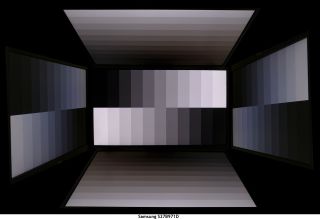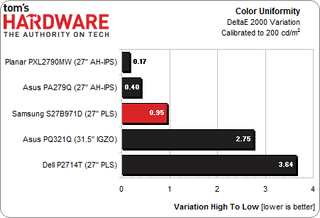Samsung S27B971D 27-Inch QHD Monitor, Reviewed
Samsung's S27B971D is a refreshed flagship 27-inch QHD monitor selling for $200 less than last-gen's model. It certainly looks impressive on paper, with its factory calibration and internal look-up table capability. Does it measure up in our lab, though?
Results: Viewing Angles And Uniformity

PLS and IPS are nearly identical technologies, so we expect similar off-axis viewing performance from both screen types. The S27B971D fares well. You can see a little light falloff in the horizontal plane and less in the vertical. The color shifts slightly towards blue as well. The detail of the darkest steps is almost, but not quite crushed. If you enlarge the photo, the difference between the bottom two brightness levels becomes more apparent.
Screen Uniformity: Luminance
To measure screen uniformity, zero- and 100-percent full-field patterns are used, and nine points are sampled. We’re now comparing the results to other monitors we've reviewed.
First, we establish a baseline measurement at the center of each screen. Then the surrounding eight points are tested, their values expressed as a percentage of the baseline (either above or below). This number gets averaged. It is important to remember that we only test the review sample each vendor sends us. Other examples of the same monitor can measure differently in this metric.
First up is black field uniformity.

Screen uniformity is one of the parameters available in the S27B971D’s internal look-up table. You can adjust it using the Natural Color Expert software and an appropriate measuring instrument. Our results are from an out-of-box configuration.
The 8.57 percent result we're showing is excellent, but it would be even better if not for the slight hotspot in the lower-right corner.
Here’s the white field measurement:
Stay On the Cutting Edge: Get the Tom's Hardware Newsletter
Join the experts who read Tom's Hardware for the inside track on enthusiast PC tech news — and have for over 25 years. We'll send breaking news and in-depth reviews of CPUs, GPUs, AI, maker hardware and more straight to your inbox.

Samsung's 1.64-percent result is the best we've ever seen by far for white field uniformity. It even exceeds the values expected from Samsung’s included data sheet! The white field pattern looks absolutely perfect from one corner to the other, with no visible variation in brightness at all.
Screen Uniformity: Color
To measure color uniformity, we display an 80-percent white field and measure the Delta E error of the same nine points on the screen. Then we subtract the lowest value from the highest to arrive at the result. A smaller number means a display is more uniform. Any value below three means a variation that is invisible to the naked eye.

Samsung includes color uniformity on its calibration chart, and our result exceeds that factory measurement as well. Remember, values below three are essentially invisible. A .35 Delta E variation is as good as non-existent. The measured errors range from .12 to 1.07 Delta E.
Unfortunately, when we reviewed Samsung's previous-gen S27B970D, we were not recording color uniformity data. So we couldn't include it in this comparison.
Current page: Results: Viewing Angles And Uniformity
Prev Page Results: Color Gamut And Performance Next Page Results: Pixel Response And Input Lag
Christian Eberle is a Contributing Editor for Tom's Hardware US. He's a veteran reviewer of A/V equipment, specializing in monitors. Christian began his obsession with tech when he built his first PC in 1991, a 286 running DOS 3.0 at a blazing 12MHz. In 2006, he undertook training from the Imaging Science Foundation in video calibration and testing and thus started a passion for precise imaging that persists to this day. He is also a professional musician with a degree from the New England Conservatory as a classical bassoonist which he used to good effect as a performer with the West Point Army Band from 1987 to 2013. He enjoys watching movies and listening to high-end audio in his custom-built home theater and can be seen riding trails near his home on a race-ready ICE VTX recumbent trike. Christian enjoys the endless summer in Florida where he lives with his wife and Chihuahua and plays with orchestras around the state.
-
cats_Paw 1000 dollars for a monitor 27 inch... nah.For that you can get a huge plasma TV if its for single player or a 300 dollar 27 inch monitor and use the 700 on something else.I still cant understand how companies expect to sell those expensive monitors to anyone but art/graphics/textures developers who actually need that picture quality.Reply -
c123456 @damianrobertjones: Do you know what comparable products cost? Apparently not. Look up a Dell U2713HM.Reply -
ubercake Contrast (even post-calibration) blows for that price. But you get a cool partially metal stand (?).Reply -
BoC_Gryphon To my knowledge, Toms has never done a review of the Korean 27" QHD monitors that can be had for ~$300-400. Please do.Reply -
Bolts Romano is it better than Apple Cinema Display in terms of color gamut and contrast?I wish i can find this monitor here in Canada so i can compare myselfSamsung Canada is very weird, it has its own flag stores here but it does not carry all the productsReply -
Bondfc11 You know this a pay to play for a review right? Of course Tom's doesn't do the korean models - or heck the Overlord Tempest lineup. What people don't get with QHD, and this includes Tom's staff, is LG has strict Tier 1 requirements for companies buying their panels that include minimum price points.Reply -
ceberle http://www.tomshardware.com/reviews/auria-eq276w-review-ips,3465.htmlReply
We covered the Auria EQ276W last April.
-Christian-
Most Popular



